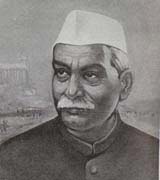Dr. Rajendra Prasad

Dr. Rajendra Prasad was born in Zeradei village in Saran dist of Bihar on December 3, 1884.His father name was Mahadev Sahai and mother name was Kamleswari Devi.At the age of five, the young Rajendra Prasad was sent to a maulvi for learning Persian. After that he was sent to Chappra Zilla School for further primary study.
Rajendra prashad was married when he was barely 12 years old to Rajvanshi Devi. He then went on to study at R.K. Ghosh's Academy in Patna to be with his older brotherMahendra Prasad. Soon afterward, however, he rejoined the Chhapra Zilla School, and it was from there that he passed the entrance examination of Calcutta University, at the age of 18. He stood first in the first division of that examination. He joined the Presidency College in 1902. He passed in 1915 with a Gold medal in Masters in Law examination with honors. He went on to complete his doctorate in Law.
Dr. Prasad called for non-cooperation in Bihar as part of Gandhiji's non-cooperation movement. Dr. Prasad gave up his law practice and started a National College near Patna, 1921.In July 1946, when the Constituent Assembly was established to frame the Constitution of India, Dr. Rajendra Prasad was elected its President. Two and a half years after independence, on January 26, 1950, the Constitution of independent India was ratified and Dr. Rajendra Prasad was elected the nation's first President. 1962, after 12 years as President, Dr. Prasad retired, and was subsequently awarded the Bharat Ratna, the nation's highest civilian award.Satyagraha at Champaran" (1922), "India Divided" (1946), his autobiography "Atmakatha" (1946), "Mahatma Gandhi and Bihar, Some Reminisences" (1949), and "Bapu ke Kadmon Mein" (1954) these were his some famous book written by him . Dr. Prasad spent the last few months of his life in retirement at the Sadaqat Ashram in Patna. He died on February 28, 1963.
